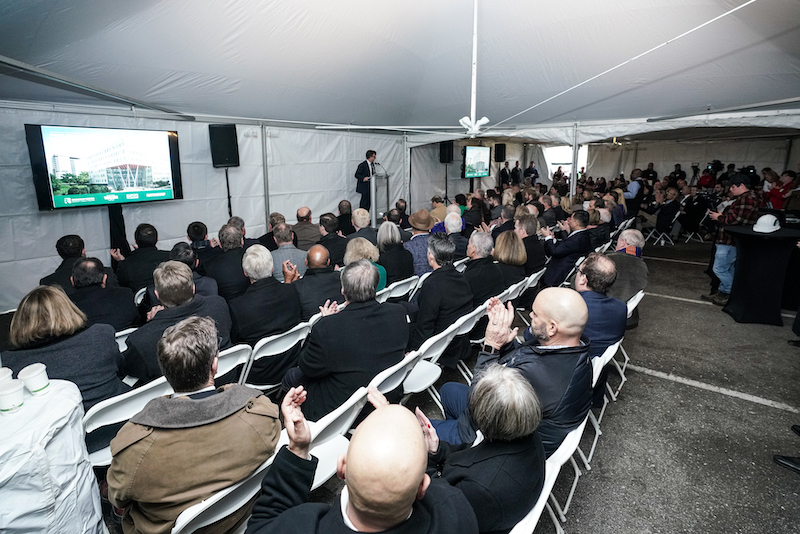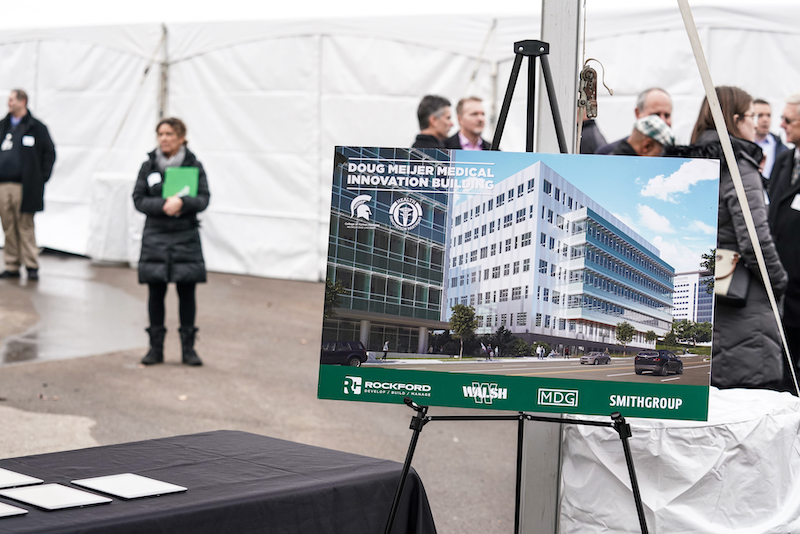Earlier this month, a real-estate development joint venture broke ground in downtown Grand Rapids, Mich., on the $85 million, 205,000-sf Doug Meijer Medical Innovation Building that is expected to drive innovation in life sciences through research, testing, and the commercialization of new therapies.
The project, which is scheduled for completion in in late 2021, is the result of a public-private partnership called Health Innovation Partners that includes Michigan State University (MSU), locally based GC Rockford Construction, and two Chicago-based firms Walsh Construction and Murphy Development Group. SmithGroup is the project’s lead architect.
Health Innovation Partners is leasing the land for the six-story Medical Innovation Building from MSU along the university’s so-called Medical Mile, next door to MSU’s 162,000-sf Research Center, which opened in 2017 and whose researchers concentrate on finding cures for cancer, Alzheimer’s and Parkinson’s diseases. The new building will include a 600-car parking structure. A third building is in the planning stage.

Over 250 guests, team members, and local officials turned out for the Nov. 18 groundbreaking of the Doug Meijer Medical Innovation Building in Grand Rapids, Mich.
MSU President Samuel L. Stanley, Jr., MD, stated during the groundbreaking ceremony that this latest project is one more step in Grand Rapids’ emergence as a national player in the health research and innovation space. Confirmed tenants for the Medical Innovation Building are the MSU College of Human Medicine, Spectrum Health, and BAMF Health, a biotech company focused on delivering AI-enabled medicine through molecular imaging and Theranostics.
Future tenants are likely to focus on cancer research, mental health, neurodevelopmental and neurodegenerative disorders, bioinformatics and artificial intelligence, digital and consumer-driven health technologies, and medical device development.
The new building is named after Doug Meijer, co-chairman of the supermarket chain Meijer, whose Meijer Foundation donated $19.5 million to the MSU Board of Trustees for the Medical Innovation Building’s construction.

Samuel L. Stanley, Jr., MD, President of Michigan State University (above), and Mike VanGessel, founder and CEO of Rockford Construction, a national construction and property management provider (below).

Related Stories
Intelligent Lighting | Feb 13, 2023
Exploring intelligent lighting usage in healthcare, commercial facilities
SSR's Todd Herrmann, PE, LEEP AP, explains intelligent lighting's potential use cases in healthcare facilities and more.
Giants 400 | Feb 9, 2023
New Giants 400 download: Get the complete at-a-glance 2022 Giants 400 rankings in Excel
See how your architecture, engineering, or construction firm stacks up against the nation's AEC Giants. For more than 45 years, the editors of Building Design+Construction have surveyed the largest AEC firms in the U.S./Canada to create the annual Giants 400 report. This year, a record 519 firms participated in the Giants 400 report. The final report includes 137 rankings across 25 building sectors and specialty categories.
Giants 400 | Feb 6, 2023
2022 Reconstruction Sector Giants: Top architecture, engineering, and construction firms in the U.S. building reconstruction and renovation sector
Gensler, Stantec, IPS, Alfa Tech, STO Building Group, and Turner Construction top BD+C's rankings of the nation's largest reconstruction sector architecture, engineering, and construction firms, as reported in the 2022 Giants 400 Report.
Healthcare Facilities | Jan 31, 2023
How to solve humidity issues in hospitals and healthcare facilities
Humidity control is one of the top mechanical issues healthcare clients face. SSR's Lee Nordholm, PE, LEED AP, offers tips for handling humidity issues in hospitals and healthcare facilities.
Augmented Reality | Jan 27, 2023
Enhancing our M.O.O.D. through augmented reality therapy rooms
Perkins Eastman’s M.O.O.D. Space aims to make mental healthcare more accessible—and mental health more achievable.
Hospital Design Trends | Jan 19, 2023
Maximizing access for everyone: A closer look at universal design in healthcare facilities
Maria Sanchez, Interior Designer at Gresham Smith, shares how universal design bolsters empathy and equity in healthcare facilities.
Fire and Life Safety | Jan 9, 2023
Why lithium-ion batteries pose fire safety concerns for buildings
Lithium-ion batteries have become the dominant technology in phones, laptops, scooters, electric bikes, electric vehicles, and large-scale battery energy storage facilities. Here’s what you need to know about the fire safety concerns they pose for building owners and occupants.
Healthcare Facilities | Dec 20, 2022
4 triage design innovations for shorter wait times
Perkins and Will shares a nurse's insights on triage design, and how to help emergency departments make the most of their resources.
Healthcare Facilities | Dec 20, 2022
Designing for a first-in-the-world proton therapy cancer treatment system
Gresham Smith begins designing four proton therapy vaults for a Flint, Mich., medical center.
Cladding and Facade Systems | Dec 20, 2022
Acoustic design considerations at the building envelope
Acentech's Ben Markham identifies the primary concerns with acoustic performance at the building envelope and offers proven solutions for mitigating acoustic issues.

















